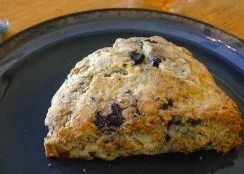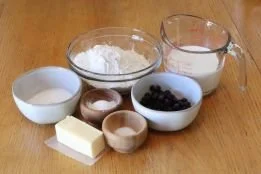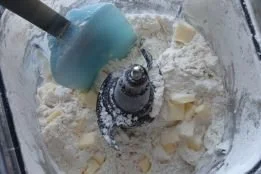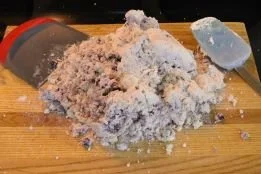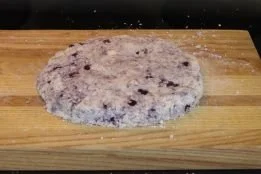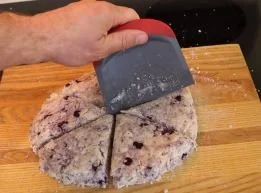Blueberry Scones
Makes 6 scones/batch
Calorie Content: Who cares? They’re too wicked good to care.
Nothing beats a warm scone right from the oven and a hot cup of tea.
I make my scones in two batches, freezing the unbaked wedges until a later time, although I may bake one up right away just to make sure they came out okay!
Over the years, I’ve discovered that using a food processor to mix the ingredients gives more consistent results than mixing by hand. Also, it’s best to use low protein flour, such as Gold Medal or Pillsbury. It will give your scones a more delicate and softer texture than high protein flour (more on this in the notes below).
After mixing all the ingredients, consider forming the round “pie” scone mixture on a cutting board which has previously been placed in the freezer. Scones should be made from cold ingredients and kept cold throughout the process. I found that by the time the dough is made, it is starting to warm. If you make the “pie” on a cold board, then put it in the freezer for fifteen minutes, the wedges of the pie will hold together better when cutting than they would have by not chilling the dough first.
Bake scones on a baking sheet in the center of the oven.
Ingredients:
2 cups flour
1 tablespoon baking powder
3 tablespoons sugar
½ teaspoon salt
5 tablespoons unsalted butter (cut into ¼-inch cubes)
½ cup of those tiny frozen Maine blueberries from the freezer isle at the grocery store. These tasty blueberries will mix better in the dough than the large, watery, tasteless “fresh” blueberries – save those for your fruit cups.
1 cup heavy cream
Musical ingredient: Big Joe Turner/Midnight Special CD
Recommended tea: Margaret’s Hope Estate Second Flush Darjeeling (black tea) from Upton Tea Imports.
Directions:
1. It is important to listen to music while making this recipe. Crank up some Big Joe!
2. Add the dry ingredients to the food processor (flour, baking powder, sugar, and salt). Shake or pulse until well blended.
3. Add a dozen or so cubes of butter at a time so they get coated in flour to keep them from sticking together. Rather than pulse the food processor, you can use a rubber spatula to mix the butter into the flour. Continue adding the remainder of the butter cubes in this manner.
4. Add blueberries and pulse/mix. All the ingredients up until this point should be well mixed in the food processor.
5. Add cream and pulse. The dough will be a clumpy and loose mixture – a bit free-spirit-like. You’ll need to give it some direction in the next step.
6. Transfer the scone mixture to a cold cutting board.
7. Form a round “pie” about eight (8) inches in diameter and 1 to 1 ½ inch thick. Place in freezer for fifteen to twenty minutes – about the time it takes to clean the food processor and other utensils. You don’t want to freeze the dough at this point – just make it a little more cohesive and stiffer.
8. Using a knife or a dough scraper (my choice), cut pie into 6 wedges. Wrap individually in plastic wrap and freeze.
Baking the scones:
I prefer freezing the unbaked scones, then baking just before eating them. However, you can bake the scones, then freeze them. Warm before eating.
Baking scones immediately after cutting the dough into wedges: 400o F for 20 minutes.
Baking frozen scones (place frozen scones on stone): 400o F for 20 to 22 minutes
Let scones cool on a wire rack for ten minutes
Notes:
What to do with the extra heavy cream?
Most likely the heavy cream you picked up at the supermarket will be in a pint container. One pint is equal to 2 cups. Since you already used 1 cup of heavy cream to make this batch of scones, and you’ve got all the ingredients and processor out anyway, why not make a second batch?
What is the difference between low protein and high protein flour?
When wet, the protein found in wheat flour, glutenin and gliadin, will join to form gluten. The more protein, the more gluten that can be created. Then as you knead the dough, the gluten forms even more bonds which sort of glues everything together. This is great for trapping gas made by yeast during the fermentation process, ultimately giving yeast-leavened baked bread a somewhat airy and chewy texture. However, you don’t want the scones to be chewy.
So, in making scones, you should opt for low protein flour (reduces the amount of gluten bonds). The rule of thumb is to use low protein flour with baking powder to make tender scones, cakes, and biscuits; and use high protein flour with yeast to make bread.
Cottage of Stone
By Deb M*
There is a little cottage down by the sea
That serves warm scones and pots of tea
An old, tired cottage made of stone
That stands pridefully all alone
An elderly couple sit outside
She hands him a scone with jam and cream applied
He pours her tea from a teapot of vivid blue
As the morning sun wakes and lazily peeks through
A scruffy little dog wanders over to her seat
Plonks himself down on top of her feet
Happily, they sit at this little cottage made of stone
A cottage abundant with love and memories
They call home!
*Printed with permission from the author.
